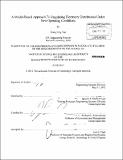| dc.contributor.advisor | Ignacio J. Pérez-Arriaga and Richard L. Schmalensee. | en_US |
| dc.contributor.author | Yap, Xiang Ling | en_US |
| dc.contributor.other | Massachusetts Institute of Technology. Technology and Policy Program. | en_US |
| dc.date.accessioned | 2012-09-13T19:01:03Z | |
| dc.date.available | 2012-09-13T19:01:03Z | |
| dc.date.copyright | 2012 | en_US |
| dc.date.issued | 2012 | en_US |
| dc.identifier.uri | http://hdl.handle.net/1721.1/72905 | |
| dc.description | Thesis (S.M. in Technology and Policy)-- Massachusetts Institute of Technology, Engineering Systems Division, Technology and Policy Program, 2012. | en_US |
| dc.description | Vita. Cataloged from PDF version of thesis. | en_US |
| dc.description | Includes bibliographical references (p. 147-152). | en_US |
| dc.description.abstract | New technologies such as distributed generation and electric vehicles are connecting to the electricity distribution grid, a regulated natural monopoly. Existing regulatory schemes were not designed for these new technologies and may not provide distribution companies with adequate remuneration to integrate the new technologies. To investigate how regulation should change in the presence of new technologies, current regulatory schemes and possible improvements to make them suitable for new technologies are reviewed. A Reference Network Model capable of calculating the costs of building a distribution network is utilized to compare the costs of accommodating different penetrations and locations of distributed generation. Results for residential generators with a 3 kW/unit power output show that as the penetration of generators among residential customers increases, costs initially decrease but then increase at higher penetration levels. A comparison of results for residential generators with results for distributed generator conurbations located far away from customers shows that residential and far away generators require similar investment costs when total distributed generation power output is lower than effective customer demand. However, when total distributed generation power output exceeds effective demand, residential generators necessitate higher investment costs than far away generators. At all levels of distributed generation power output, residential generators imply lower losses costs than far away generators. A second Reference Network Model capable of calculating the costs of expanding an existing distribution network is utilized to compare the costs of expanding a network to accommodate new technologies under different technology management approaches. Results show that network investment costs are lower for an actively managed network than for a passively managed network, illustrating the potential benefits of active management. Based on an analysis of the modeling results and the regulatory review, an ex ante schedule of charges for distributed generators that incorporates forecast levels of DG penetration is suggested to improve remuneration adequacy for the costs of integrating distributed generation. To promote active management of distribution networks, measures such as funding pots, outputs-focused regulatory schemes, and regulating total expenditure rather than separating the regulation of capital and operating expenditure are selected as proposals. | en_US |
| dc.description.statementofresponsibility | by Xiang Ling Yap. | en_US |
| dc.format.extent | 152 p. | en_US |
| dc.language.iso | eng | en_US |
| dc.publisher | Massachusetts Institute of Technology | en_US |
| dc.rights | M.I.T. theses are protected by
copyright. They may be viewed from this source for any purpose, but
reproduction or distribution in any format is prohibited without written
permission. See provided URL for inquiries about permission. | en_US |
| dc.rights.uri | http://dspace.mit.edu/handle/1721.1/7582 | en_US |
| dc.subject | Engineering Systems Division. | en_US |
| dc.subject | Technology and Policy Program. | en_US |
| dc.title | A model-based approach to regulating electricity distribution under new operating conditions | en_US |
| dc.type | Thesis | en_US |
| dc.description.degree | S.M.in Technology and Policy | en_US |
| dc.contributor.department | Massachusetts Institute of Technology. Engineering Systems Division | |
| dc.contributor.department | Technology and Policy Program | |
| dc.identifier.oclc | 808499324 | en_US |
